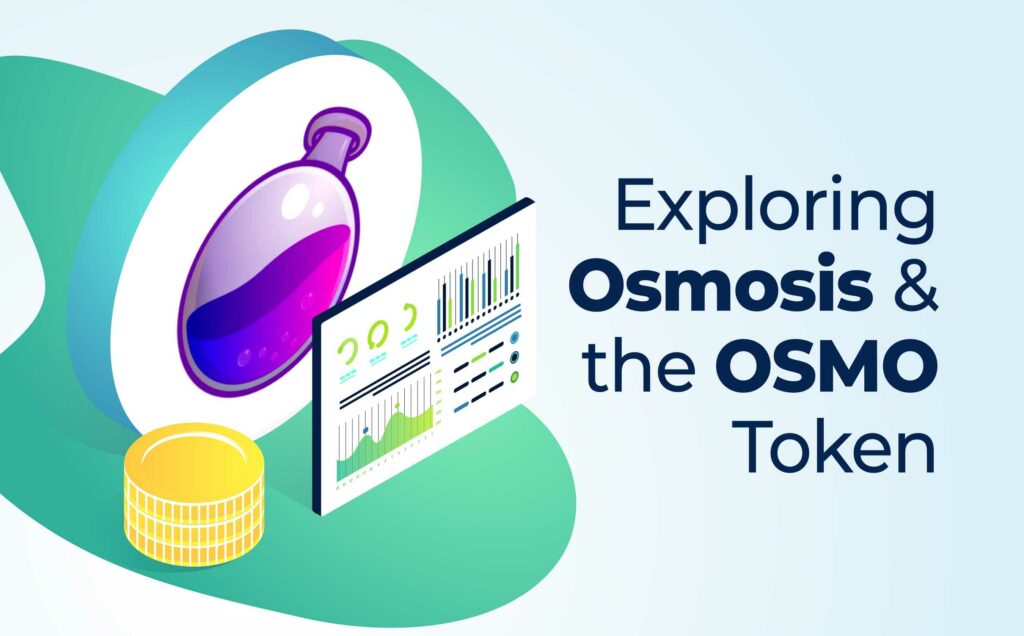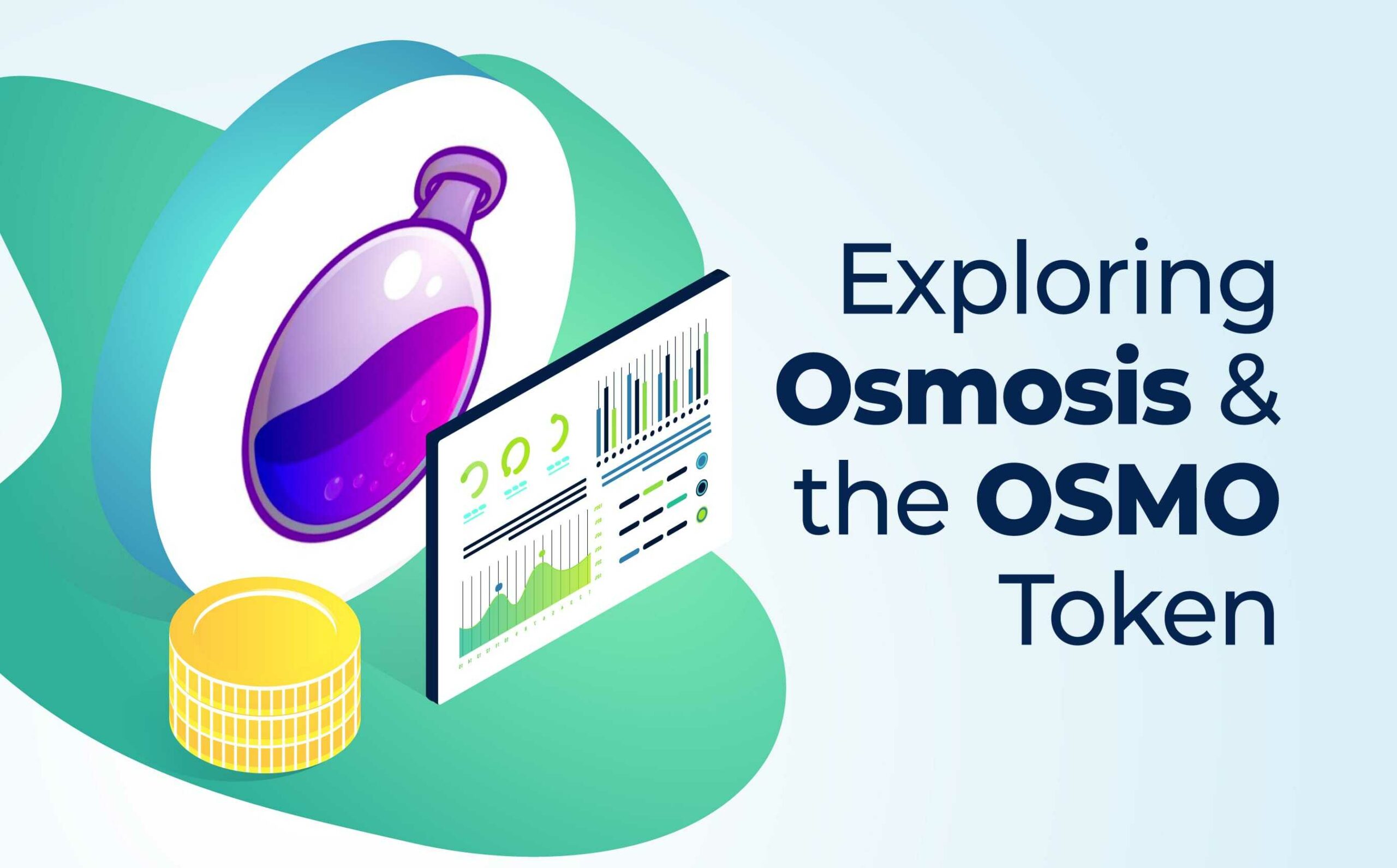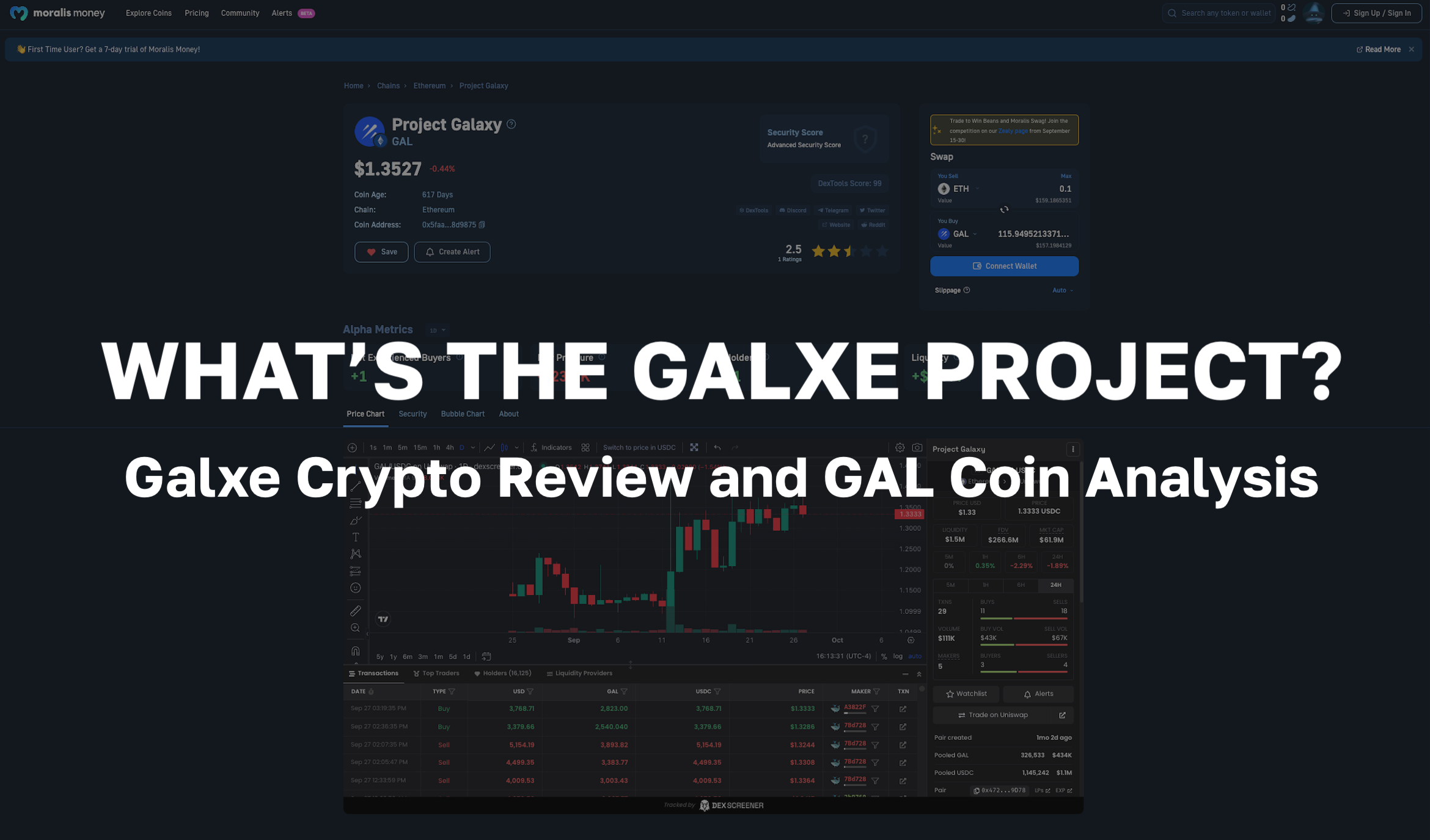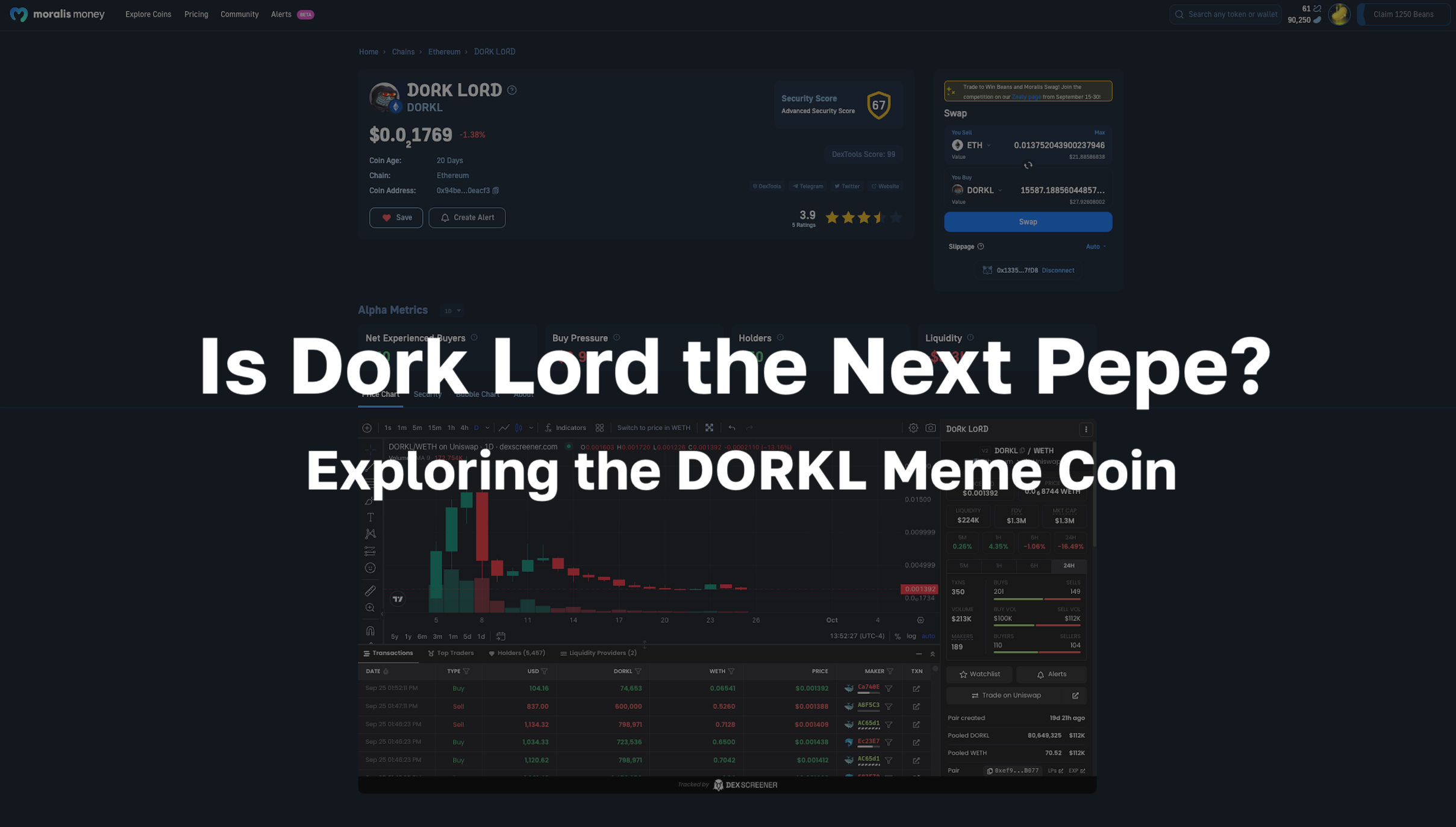
The Osmosis exchange is introducing a new adaptable automated market maker (AMM) model operating within the Cosmos ecosystem. Appealing to both crypto traders and developers, the Osmosis crypto ecosystem offers a variety of use cases for its native Osmosis token and interoperable, modular tools for developers. Presenting the potential for the next decentralized finance (DeFi) paradigm shift, the Cosmos AMM offers full customizability with protocol parameters. Also, the OSMO token enables liquidity providers to have governance over individual pools they’re participating in. Furthermore, the Osmosis AMM provides frictionless low-cost cross-chain transactions.
In this article, we are going to dive deep into the Osmosis crypto ecosystem. We’ll explore the Osmosis exchange, the Osmosis token (OSMO), and how they interoperate within the Cosmos ecosystem. Plus, we’ll look at ways in which OSMO token holders can earn a passive income!
For a breakdown of the fundamentals of blockchain technology, our Blockchain & Bitcoin 101 and Ethereum 101 courses are a great place to start! Moralis Academy offers an all-in-one space for discovering the basics of blockchain using an interactive learning style. Moreover, we provide an engaging student community forum for students to meet like-minded people. You could meet an online study buddy or business partner! Join over 30,000 welcoming students today, at Moralis Academy!
What is Osmosis Exchange?
Announced in February 2021, Osmosis is a next-generation automated market maker (AMM)-based decentralized exchange (DEX). With an attractive and operational minimum viable product (MVP), Osmosis is designed using the Cosmos SDK (software development kit). As such, this allows the protocol to be interoperable and flexible in novel ways.
Developers can leverage the Osmosis protocol to design their own AMM decentralized application (dApp). Furthermore, Osmosis provides extensive customizability with governance mechanisms allowing liquidity providers to govern the pools they’re active in. In turn, Osmosis is re-designing the one-size-fits-all approach, offering developers truly decentralized, interoperable, and adaptable tools to deploy their own AMMs.
While the mainnet protocol is still in development, the active minimum viable product (MVP) offers insight into the features available. Moreover, the native Osmosis token (OSMO) enables platform governance and decentralization. Following the mainnet launch, OSMO token holders will be able to participate in on-chain voting on platform parameter updates and proposals.
Cosmos Blockchain Ecosystem
Cosmos is one of the longest-standing active blockchain projects with a focus on interoperability. Launched via a successful initial coin offering (ICO) in 2017, Cosmos Network is sometimes known as the “internet of blockchains”. Operating as a network of blockchains as opposed to one single chain, the Cosmos blockchain ecosystem facilitates frictionless interoperability with other leading blockchains in the space. Cosmos achieves this through its novel inter-blockchain communication (IBC) protocol. Moreover, the IBC protocol allows users to communicate with other blockchains using both cryptocurrencies and non-fungible tokens (NFTs).
The Cosmos Inter-blockchain communication (IBC) protocol will be “baked” into the Osmosis smart contracts from day one. Osmosis believes using the Cosmos software development kit (SDK) will yield the best results thanks to its reliability, scalability, and easy-to-use modular frameworks.
Osmosis Token (OSMO)
The Osmosis token (OSMO) is key to the smooth-running operations plus the growth and direction of the protocol. The multi-utility OSMO token has three main responsibilities in the Osmosis Network. These are liquidity provision, covering transaction costs, and protocol governance. OSMO token holders can have voting rights on platform parameters, including which liquidity pools can receive rewards, how many rewards they receive, plus staking facilities and network fees. Therefore, the Osmosis exchange encourages and promotes the importance of community participation, particularly if token holders are participating in governance.
The protocol frequently introduces new updates and features and wants the Osmosis token (OSMO) holder governance community to shape the project’s direction. Moreover, Osmosis used a fair distribution model to introduce its native tokens into circulation. With no pre-sale or seed-round, Osmosis distributed the initial 100 million genesis tokens to early adopters, including developers, stakers, and liquidity providers, among others. Through the token distribution, the genesis tokens were split 50% each between the Quadratic Fairdrop participants and a ‘strategic reserve’. The strategic reserve is a recently-introduced fund to cover rewards for participants carrying out important tasks on the Osmosis network. Further, the project team believes “the strategic reserve will be crucial in aligning key advisors”.
Most Cosmos SDK blockchains distribute tokens on a per-block basis. This means, for each block confirmation on the network, miners or validators receive a percentage of tokens as rewards. However, with the Osmosis blockchain, the project distributes Osmosis tokens (OSMO) at the end of each daily epoch. Further, similar to Bitcoin’s halving event, Osmosis is introducing an annual “thirdening” event for the OSMO token issuance. This means the rate of issuance will decrease by one-third each year (or 365 epochs).
Quadratic Fairdrop
As per Osmosis’ quadratic fairdrop distribution model, holders of Cosmos’ native ATOM can claim free Osmosis tokens (OSMO)! A snapshot of holdings of ATOM token holders was taken in February 2021. The amount of OSMO tokens holders are entitled to claim is equivalent to the square root of the number of ATOM tokens held at the time of the snapshot. Plus, holders who were staking their ATOM received a 2.5X multiplier.
The “quadratic” element of the token distribution takes place when ATOM holders come to claim their free OSMO tokens. Initially, ATOM holders will receive 20% of their OSMO tokens as liquid assets, free to use and trade. The remaining 80% of airdrop holdings can be claimed through participating in four community on-chain tasks. These are:
- Carrying out a swap on the Osmosis exchange
- Add some liquidity to any pool
- Stake OSMO token holdings
- Place a vote on a governance proposal
Through completing each task, users receive an additional 20% of their airdrop total. This means only active supporters of the Osmosis crypto project will receive the full airdrop amount. Further, the quadratic fairdrop model offers all Cosmos token holders a fair opportunity to participate and earn OSMO tokens.
Osmosis AMM Liquidity Providers and Bonded Liquidity Gauges
Decentralized finance (DeFi) is responsible for introducing yield farming, a smart contract-based solution offering users substantial returns for increasing risk by leveraging their assets. While yield farming may present users with a hefty and quick return on investment, the volatility and short-lived nature of yield farming comes with inherent risks to both the farmers and automated market makers (AMMs).
If a significant amount of farmers engage in short-term farming activities, this can result in volatile liquidity for AMM pools. In turn, this can present major challenges and unreliability for other traders of the AMM. In response to this, Osmosis wants to incentivize liquidity providers (LPs) to provide long-term liquidity. It achieves this in two ways. Firstly, there is a small exit fee for LPs to pay when withdrawing their liquidity. Secondly, Osmosis implements an incentivization mechanism called “Bonded Liquidity Gauges”.
Bonded Liquidity Gauges incentivize users to bond their LP tokens with higher rewards for longer bonding time. Plus, users can decide on their own bonding period. Further, users can receive rewards from multiple gauges with the same LP tokens. For example, let’s say Alice wants to bond her ATOM/OSMO LP tokens and puts 50% into Gauge 2 and 50% into Gauge 3. With her first bonding, Alice will earn rewards on Gauge 1 and 2. However, her second position means Alice earns rewards for two weeks, including rewards from Gauge 1, Gauge 2, and Gauge 3. Almost half (45%) of the daily OSMO token issuance goes towards rewarding liquidity incentives.
Users are free to unbond their LP tokens at any time. However, there is a two-week unbonding period. At this stage, users can submit another request to withdraw their tokens. Users receive rewards as liquid Osmosis tokens (OSMO) that do not need to go through the unbonding process.
How is Osmosis AMM Different?
The Osmosis automated market maker (AMM) is a project catering to both crypto traders and blockchain developers alike. Thanks to using the Cosmos SDK, the Osmosis exchange is fully interoperable with cross-chain asset transactions. During the initial minimum viable product (MVP) launch, the Osmosis exchange will operate across all chains within the Cosmos ecosystem. Following this, the Osmosis AMM will begin to integrate ERC-20 compatibility using the Althea gravity bridge and other non-IBC (inter-blockchain communication) chains. This also includes “a variety of Bitcoin-like chains”. Moreover, the project’s liquidity providers (LPs) can customize the weighting of assets in liquidity pools, similarly to how Balancer protocol operates.
The Osmosis AMM recognizes the need for flexibility, adaptability, and transparency for innovations of decentralized finance (DeFi) to flourish. As such, all code is completely open-source with true customizability. The project offers developers personalizable parameters as with Osmosis, “nothing about the underlying structure of AMMs is hard-coded”. This means developers can choose individual aspects such as algorithm curves, fees, and time-weighted average price (TWAP) calculations. Furthermore, developers can even design their own mathematical expressions for pool creations!
Additionally, developers can implement the Osmosis exchange with off-chain oracles and include data points more powerful than any existing automated market maker model (AMM). Traditional AMMs use token balance quantities, whereas using the Osmosis exchange, developers can introduce volatility indexes, dynamic fee markets, and time dependencies for assets. Moreover, developers can seamlessly introduce updates to their AMM applications using existing Osmosis AMM liquidity, order flow, and IBC (inter-blockchain communication) connections.
Full details surrounding plans and dates of implementation are expected in a future roadmap. However, below we outline the services currently available on Osmosis.
Trade
Users can interact with frictionless cross-chain transactions of cryptocurrency assets within the Cosmos ecosystem. The graphical user interface (GUI) is simple by design, providing a familiar experience to other automated market makers (AMMs) such as Uniswap, PancakeSwap, and SushiSwap. To begin trading, users must first connect with a Keplr wallet, either the Keplr Browser Extension or Keplr Mobile. As a Web3 wallet, Keplr operates in a similar manner to leading browser wallet MetaMask.
For an in-depth tutorial on installing and using MetaMask with DeFi protocols such as Uniswap, Curve Finance, and Aave, see our DeFi 101 course! Moralis Academy is the largest online blockchain education suite catering to a range of backgrounds and learning styles. Begin your DeFi journey with Moralis Academy today!
Pools
This section of the Osmosis exchange presents users with a dashboard displaying a live price feed of the native Osmosis token (OSMO). Also, users can view the rewards distribution countdown timer and any pools they are actively participating in. Additionally, the Pools tab offers the full list of different incentivized liquidity pools for a variety of different assets. Pools feature the Pool number, the asset pairing, annual percentage rewards (APR), and the amount of liquidity in the pool.
Furthermore, the “Assets” tab underneath “Pools” provides Osmosis exchange users with a full list of assets available. This presents another dashboard view for users to manage and keep a check on different assets, including the amount of available, bonded, and staked assets.
Staking
Users can partake in Osmosis token (OSMO) staking using the Keplr browser wallet, accessible through a separate site via the “Staking” tab on the Osmosis exchange menu. Upon opening a new window, users receive a prompt to either sign in or install the Chrome extension wallet. Then, users can view a list of 100 validators to commit their OSMO token stake to. Users can view the validator name, ranking, voting power (number of OSMO tokens held), and the commission percentage.
Governance
Another option available through the Keplr wallet application is voting facilities via the “Governance” tab on the Osmosis exchange. The Cosmos automated market maker (AMM) project presents users with any open governance update proposals. Proposals display the parameters of the update and voting period. Additionally, users can view previous governance proposals.
Exploring Osmosis Exchange and the OSMO Token Summary
Introducing a new model of automated market maker (AMM), the Osmosis exchange is one of the first Cosmos AMM applications. Plus, Osmosis is the pioneering platform for offering participant governance for individual liquidity pools and customizable pools parameters for developers. Further, developers can employ Osmosis incentivization mechanisms on third-party platforms to increase long-term liquidity provision. Moreover, as the project uses the Cosmos SDK (software development kit), end-users can enjoy super-fast, low-cost cross-chain transactions.
As the project is developing its working minimum viable product (MVP), the novel Osmosis AMM will become interoperable with blockchains external to the Cosmos ecosystem with further updates. Additionally, the growth and direction of the Cosmos AMM are governed by native Osmosis token (OMSO) holders. Further, the innovative and customizable Osmosis AMM offers OSMO token holders the opportunity to earn a passive income with staking and liquidity rewards.
If you would like to learn more about how to make the most out of decentralized finance (DeFi), see the DeFi 201 course at Moralis Academy! This course shows students how to take their DeFi skills to the next level with crypto arbitrage, decentralized hedge funds, and yield farming opportunities. Also, don’t forget to follow us on Twitter @MoralisAcademy! We’d love to know your thoughts about the Osmosis AMM and OSMO token!





